 Belenganjur player | |
| Developed | Indonesia |
|---|---|
Gamelan beleganjur (also spelled balaganjur) is one of the most popular styles of gamelan music in Bali. Its closest Western analogue is probably the Western military band.
 Belenganjur player | |
| Developed | Indonesia |
|---|---|
Gamelan beleganjur (also spelled balaganjur) is one of the most popular styles of gamelan music in Bali. Its closest Western analogue is probably the Western military band.
Like the Western military band, the original purpose of beleganjur was to accompany armies into battle and strike fear into the hearts of the enemy. In fact, gamelan beleganjur literally means "gamelan of walking warriors". Also like its Western counterpart, today beleganjur has mostly lost its association with warfare, and instead is associated with festivals, contests, and cremation ceremonies - modeled on the modern marching band and the Javanese tanjidor tradition to the west.
Although the origin of beleganjur is uncertain, it bears resemblance to the now rare gamelan gong bheri .
The most primitive beleganjur ensemble, known as bebatelan, consisted of only nine instruments:
The drums and cymbals generally play interlocking patterns over the ostinato of the gongan gong cycle.
Though bebatelan itself is rarely heard nowadays, its instrumentation forms the nucleus of the more complex modern ensemble: beleganjur bebonangan. The additional instrumentation of the beleganjur bebonangan ensemble is:
The bonang are identical to the individual pots of the reyong ; in fact, many groups simply remove the pots from the frame of a reyong so they can double as bonang, and bonang are often referred to as reyong for this reason. The ponggang usually play a characteristic ostinato pattern while the bonang play more complex interlocking patterns known as kotekan .

Gamelan beleganjur is essential to the Hindu religious ceremonies of Bali, such as the ogoh-ogoh parades before the Balinese New Year, Nyepi. There are rites to appease evil spirits and honor good ones, temple festivals to celebrate the anniversary of a temple's dedication, and cremation ceremonies to cleanse the souls of the deceased and prepare them for reincarnation. Though some ceremonies are associated with other specific kinds of gamelan, notably cremation ceremonies with gamelan angklung , beleganjur is nevertheless ubiquitous and often takes the place of other kinds of gamelan if they are not available.
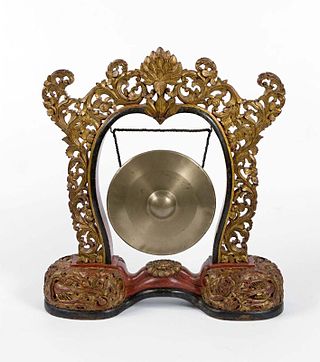
A gong is a percussion instrument originating in East Asia and Southeast Asia. Gongs are a flat, circular metal disc that is typically struck with a mallet. They can be small or large in size, and tuned or can require tuning.

Gamelan is the traditional ensemble music of the Javanese, Sundanese, and Balinese peoples of Indonesia, made up predominantly of percussive instruments. The most common instruments used are metallophones played by mallets and a set of hand-played drums called kendang, which register the beat. The kemanak and gangsa are commonly used gamelan instruments in Bali. Other instruments include xylophones, bamboo flutes, a bowed instrument called a rebab, a zither-like instrument siter and vocalists named sindhen (female) or gerong (male).

As it is a country with many different tribes and ethnic groups, the music of Indonesia itself is also very diverse, coming in hundreds of different forms and styles. Every region has its own culture and art, and as a result traditional music from area to area also uniquely differs from one another. For example, each traditional music are often accompanied by their very own dance and theatre. Contemporary music scene have also been heavily shaped by various foreign influences, such as America, Britain, Japan, Korea, and India.

Gamelan gong kebyar is a style or genre of Balinese gamelan music of Indonesia. Kebyar means "to flare up or burst open", and refers to the explosive changes in tempo and dynamics characteristic of the style.
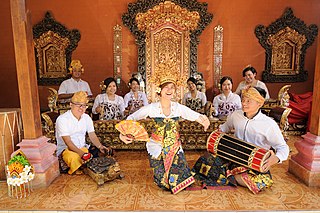
The Music of Bali, Bali is an Indonesian island that shares in the gamelan and other Indonesian musical styles. Bali, however, has its own techniques and styles, including kecak, a form of singing that imitates the sound of monkeys. In addition, the island is home to several unique kinds of gamelan, including the gamelan jegog, gamelan gong gede, gamelan gambang, gamelan selunding and gamelan semar pegulingan, the cremation music angklung and the processional music bebonangan. Modern popular styles include gamelan gong kebyar, dance music which developed during the Dutch occupation and 1950s era joged bumbung, another popular dance style. In Balinese music you can also hear metallophones, gongs and xylophones.

Joged bumbung is a style of gamelan music from Bali, Indonesia on instruments made primarily out of bamboo. The ensemble gets its name from joged, a flirtatious dance often performed at festivals and parties. This style of Gamelan is especially popular in Northern and Western Bali, but is easily found all over the island. Unlike many styles of Balinese Gamelan which have sacred roles in religious festivals, Joged music is much more secular, and in many ways has become the folk music of Bali. With the rapid rise of tourism in recent decades, Joged music is now often found being performed at hotels and restaurants.

Gamelan surakarta A typical large, double gamelan in contemporary solo (Surakarta) will include, in the sléndro set, one saron panerus, two saron barung, one or two saron demung, one gendér panerus, one gender barung, one slenthem, one bonang panerus and one bonang barung, one gambang kayu, one siter or celempung, one rebab, one suling, one pair of kethuk and kempyang, one set of three to five kenong, one set of three to five kempul, one to three gong suwukan, and one gong ageng.

The angklung is a musical instrument from the Sundanese people in Indonesia made of a varying number of bamboo tubes attached to a bamboo frame. The tubes are carved to have a resonant pitch when struck and are tuned to octaves, similar to Western handbells. The base of the frame is held in one hand, while the other hand shakes the instrument, causing a repeating note to sound. Each performer in an angklung ensemble is typically responsible for just one pitch, sounding their individual angklung at the appropriate times to produce complete melodies.

Kotekan is a style of playing fast interlocking parts in most varieties of Balinese Gamelan music, including Gamelan gong kebyar, Gamelan angklung, Gamelan jegog and others.

A gangsa is a type of metallophone which is used mainly in Balinese and Javanese Gamelan music in Indonesia. In Balinese gong kebyar styles, there are two types of gangsa typically used: the smaller, higher pitched kantilan and the larger pemade. Each instrument consists of several tuned metal bars each placed over an individual resonator. The bars are hit with a wooden panggul, each producing a different pitch. Duration of sound intensity and sound quality factors are generally accomplished by damping the vibration of the bar with the fingers of the free hand. Balinese gong kebyar gangsas, as with other metallophones in gong kebyar ensembles, are played in neighboring pairs with interlocking, rapid-tempo parts that elaborate on the melody of a piece of music ; these pairs are tuned to be dissonant and create certain wavelengths of sympathetic vibrations to create a shimmering tone that travels long distances. The gangsa is very similar to the old gendér and the saron.

A gendèr is a type of metallophone used in Balinese and Javanese gamelan music. It consists of 10 to 14 tuned metal bars suspended over a tuned resonator of bamboo or metal, which are tapped with a mallet made of wooden disks (Bali) or a padded wooden disk (Java). Each key is a note of a different pitch, often extending a little more than two octaves. There are five notes per octave, so in the seven-note pélog scale, some pitches are left out according to the pathet. Most gamelans include three gendèr, one for sléndro, one for pelog pathet nem and lima, and one for pelog pathet barang.
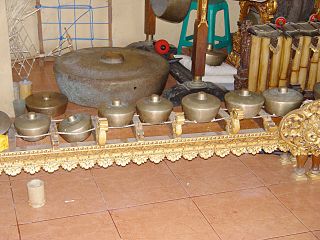
The reyong is a musical instrument used in Balinese gamelan. It consists of a long row of metal gongs suspended on a frame. In gamelan gong kebyar, it is played by four players at once, each with two mallets.

Gamelan semar pegulingan is an old variety of the Balinese gamelan. Dating back from around the 17th century, the style is sweeter and more reserved than the more popular and progressive Gamelan Gong Kebyar. Semar pegulingan is derived from the ancient flute ensemble gamelan gambuh which utilizes a 7 tone scale. Semar pegulingan also uses the 7 tone scale which enables several pathet to be played. Semar is the name of the Hindu God of love and pegulingan means roughly 'laying down'. It was originally played near the sleeping chambers of the palace to lull the king and his concubines to sleep. The ensemble includes suling, various small percussion instruments similar to sleigh bells and finger cymbals, and trompong - a row of small kettle gongs that play the melody. A similar type of ensemble, Gamelan Pelegongan, substitutes a pair of gendérs for the trompong as the melody carrier and plays the music for a set of dances known as legong.

The gong ageng is an Indonesian musical instrument used in the Javanese gamelan. It is the largest of the bronze gongs in the Javanese and Balinese gamelan orchestra and the only large gong that is called gong in Javanese. Unlike the more famous Chinese or Turkish tam-tams, Indonesian gongs have fixed, focused pitch, and are dissimilar to the familiar crash cymbal sound. It is circular, with a conical, tapering base of diameter smaller than gong face, with a protruding polished boss where it is struck by a padded mallet. Gongs with diameter as large as 135 centimeters have been created in the past, but gongs larger than about 80 centimeters are more common especially to suit the budget of educational institutions.
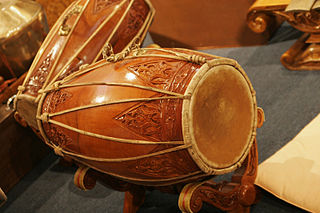
A kendang or gendang is a two-headed drum used by people from the Indonesian Archipelago. The kendang is one of the primary instruments used in the gamelan ensembles of Javanese, Sundanese, and Balinese music. It is also used in various Kulintang ensembles in Indonesia, Brunei, Malaysia, Singapore, and the Philippines. It is constructed in a variety of ways by different ethnic groups. It is related to the Indian double-headed mridangam drum.

The bonang is an Indonesian musical instrument used in the Javanese gamelan. It is a collection of small gongs placed horizontally onto strings in a wooden frame (rancak), either one or two rows wide. All of the kettles have a central boss, but around it the lower-pitched ones have a flattened head, while the higher ones have an arched one. Each is tuned to a specific pitch in the appropriate scale; thus there are different bonang for pelog and slendro. They are typically hit with padded sticks (tabuh). This is similar to the other cradled gongs in the gamelan, the kethuk, kempyang, and kenong. Bonang may be made of forged bronze, welded and cold-hammered iron, or a combination of metals. In addition to the gong-shaped form of kettles, economical bonang made of hammered iron or brass plates with raised bosses are often found in village gamelan, in Suriname-style gamelan, and in some American gamelan. In central Javanese gamelan there are three types of bonang used:

Gamelan gender wayang is a style of gamelan music played in Bali, Indonesia. It is required for wayang and most sacred Balinese Hindu rituals. The smallest of gamelan ensembles, it requires only two players and is complete at four, the additional instruments doubling an octave above. Like other gamelan genres, it incorporates delicate interlocking melodies and active contrapuntal movement, yet poses unique challenges in technique and composition.
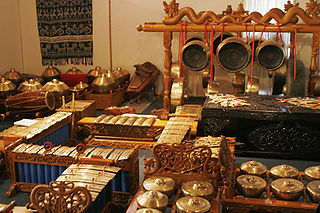
A gong chime is a generic term for a set of small, high-pitched bossed pot gongs. The gongs are ordinarily placed in order of pitch, with the boss upward on cords held in a low wooden frame. The frames can be rectangular or circular, and may have one or two rows of gongs. They are played by one to four musicians, each using two padded sticks to strike them. They are an important instrument in many Southeast Asian musical ensembles, such as Indonesian gamelan, kulintang, or Thai pi phat. For this reason, such ensembles are sometimes called "gong chime ensembles" or "gong chime orchestras," and the broad variety of music "gong chime music."

Gambuh is an ancient form of Balinese dance-drama. It is accompanied by musicians in a gamelan gambuh ensemble.

Gendang beleq is a dance and music performance from Lombok island, Indonesia. It is a popular performance among the native Sasak people.